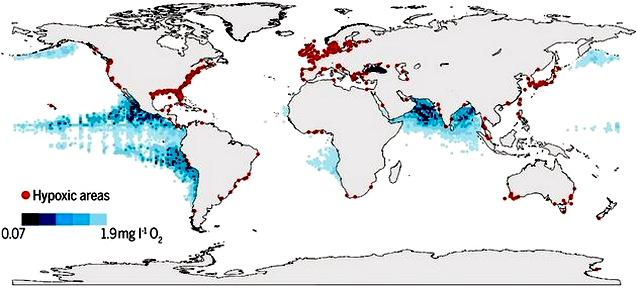Suffocating oceans could lead to ecosystem collapse, the study says.
The size of oxygen-starved ocean “dead zones,” where plants and animals struggle to survive, has increased fourfold around the world, according to a new scientific analysis.
The growth of the zones is yet another consequence of global warming — including increasing ocean temperatures — triggered by greenhouse gases and, closer to the coasts, contamination by agricultural runoff and sewage.
 |
| Declining Oxygen in the Global Ocean and Coastal Waters/Science |
The analysis of the oxygen-starved zones was conducted by a team of scientists from the Global Oxygen Network (GO2NE), created in 2016 by the Intergovernmental Oceanographic Commission of the United Nations.
Researchers determined that open-ocean “oxygen-minimum” zones have expanded since 1950 by an area roughy equivalent to the size of the European Union. The volume of ocean water completely devoid of oxygen has more than quadrupled in that time, the study found. The number of hypoxic, or oxygen depleted, zones along coasts has increased up to 10 times, from less than 50 to 500.
Denise Breitburg, a marine ecologist at the Smithsonian Environmental Research Center and lead author of the study, called the plunge in ocean oxygen “among the most serious effects of human activities on the Earth’s environment.” Oxygen is “fundamental to life in the oceans,” she said in a statement.
“If you can’t breathe, nothing else matters,” Breitburg told The Associated Press. “As seas are losing oxygen, those areas are no longer habitable by many organisms.”
But the threat isn’t just to life in the oceans, which account for about half of the oxygen on the planet.
“Major extinction events in Earth’s history have been associated with warm climates and oxygen-deficient oceans,” the study warns.
Consequences for ocean life can be significant even in areas where oxygen is merely low. Sea life may be stunted and immune responses impaired in such areas, resulting in poor survival rates and a decrease in healthy diversity, scientists warn.
The scientists recommend salvaging oxygen-starved areas by tackling climate change and nutrient pollution, focusing on protecting particularly vulnerable sea life with no-catch or no-fishing zones, and increasing and improving surveillance of areas where oxygen is plummeting.
Breitburg concedes that addressing global warming can seem daunting, but she says focused local efforts to protect areas can be effective. She points to changes in the Chesapeake Bay, where nitrogen pollution dropped 24 percent from its worst levels after sewage treatment and protections mandated by the Clean Air Act began. Areas of the bay with zero oxygen zones have nearly vanished, according to Breitburg.
Even with “ambitious emission reductions,” however, numerical models project “further oxygen declines during the 21st century,” the study warns.
Links
- What is a dead zone?
- Declining oxygen in the global ocean and coastal waters
- Intergovernmental Oceanographic Commission
- The Ocean Is Losing Its Breath. Here's the Global Scope.
- Low oxygen levels, coral bleaching getting worse in oceans
- Oceans suffocating as huge dead zones quadruple since 1950, scientists warn























